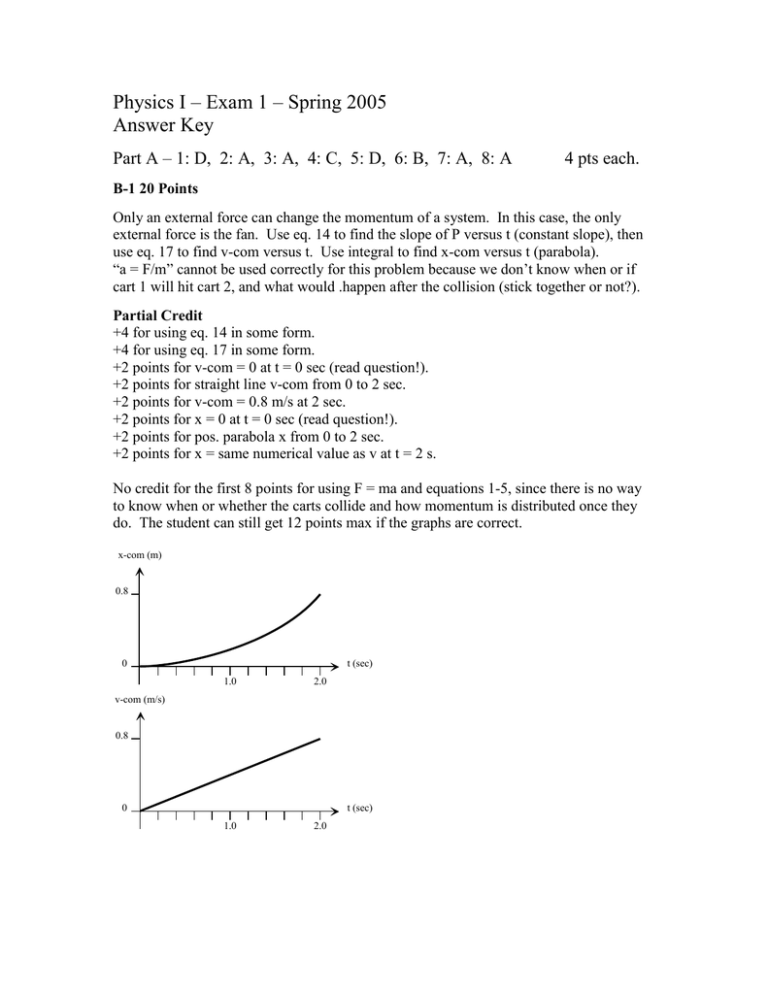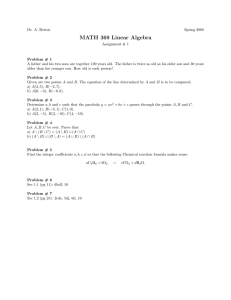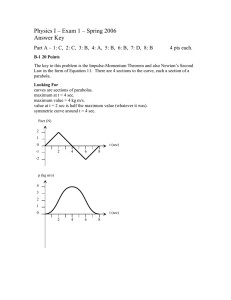Physics I – Exam 1 – Spring 2005 Answer Key
advertisement

Physics I – Exam 1 – Spring 2005 Answer Key Part A – 1: D, 2: A, 3: A, 4: C, 5: D, 6: B, 7: A, 8: A 4 pts each. B-1 20 Points Only an external force can change the momentum of a system. In this case, the only external force is the fan. Use eq. 14 to find the slope of P versus t (constant slope), then use eq. 17 to find v-com versus t. Use integral to find x-com versus t (parabola). “a = F/m” cannot be used correctly for this problem because we don’t know when or if cart 1 will hit cart 2, and what would .happen after the collision (stick together or not?). Partial Credit +4 for using eq. 14 in some form. +4 for using eq. 17 in some form. +2 points for v-com = 0 at t = 0 sec (read question!). +2 points for straight line v-com from 0 to 2 sec. +2 points for v-com = 0.8 m/s at 2 sec. +2 points for x = 0 at t = 0 sec (read question!). +2 points for pos. parabola x from 0 to 2 sec. +2 points for x = same numerical value as v at t = 2 s. No credit for the first 8 points for using F = ma and equations 1-5, since there is no way to know when or whether the carts collide and how momentum is distributed once they do. The student can still get 12 points max if the graphs are correct. x-com (m) 0.8 0 t (sec) 1.0 2.0 v-com (m/s) 0.8 0 t (sec) 1.0 2.0 Part C Must show work to receive credit. C-1 24 points The vertical (Y) motion of the cannonball is independent of the horizontal (X) motion. We will solve the Y motion first. V0,y = V0 sin(30°) = 196 * ½ = 98 m/s. At the highest point, Vy = 0 → 0 = V0,y – g t1 → t1 = 98 ∕ 9.8 = 10 s. Can use any of equations 2-5 to find highest point, here is equation 3: Ymax = Y0 + ½ (V0,y + 0) t1 = 1470 + ½ (98) (10) = 1960 m (above valley) Time to fall to the ground is most easily found using equation 2: 0 = 1960 – ½ g (t2)2 → t2 = sqrt(2*1960/9.8) = 20 s. The total time of flight is 10 + 20 = 30 s. To find d, use a constant X velocity: V0,x = V0 cos(30°) = 196 * 0.866 = 169.74 m/s. d = 169.74 * 30 = 5092 m C-2 24 points Use Conservation of Momentum. Let X = right, Y = up on page. Px = (1.250 x 106)(4000) = 5.000 x 109 kg m/s. Py = 0. Let piece 1 (m1) be the upper part, and let piece 2 (m2) be the lower part. After collision in X direction: V1x = (2000) cos(30°) = 1732 m/s. Px = (1.250 x 106) (2268) + m1 (1732) Solving gives m1 = 1.250 x 106 kg (same as first asteroid). After collision in Y direction: V1x = (2000) sin(30°) = 1000 m/s. From this, we know that m1 = m2 because Py = 0. The total mass of the second asteroid is 2.500 x 106 kg.


